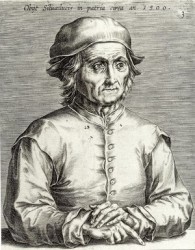
Ebeling 1948
“Jheronimus van Aken” (H.J.M. Ebeling) 1948
[in: Miscellanea J. Gessler, part I, s.l. (Antwerp), 1948, pp. 444-457]
[Also mentioned in Gibson 1983: 27 (B1)]
Ebeling (city archivist of ’s-Hertogenbosch) offers a number of critical remarks on what other authors have written about the life of Hieronymus Bosch. These remarks are mainly based on the ‘Accounts’ of the Fraternity of Our Lady. The name ‘Bosch’ occurs for the first time in an account of Philip the Fair dating from 1504, proving that the Burgundian duke ordered a painting from Bosch: ‘Jéronimus van Aeken, dit Bosch, paintre, demeurant au Bois-le-Duc’ (Hieronymus van Aken, called Bosch, painter, living in ’s-Hertogenbosch). The second time the name occurs in an account of the Fraternity dating from 1509/10: ‘Jheronimus van Aken, scilder, die hem scrift Bosch’ (Hieronymus van Aken, painter, who call himself Bosch).
Hieronymus’ father was called ‘Anthonis’, which is confirmed by a Fraternity account from 1486/87, signalling that ‘Jheronimus Anthonissoen van Aken’ (Anthonissoen meaning ‘son of Anthonis’) was enlisted as a new member, and by a ’s-Hertogenbosch schepenakte (aldermen’s deed) from 1520: ‘Jheronimum de Aken, filium quondam Anthonii, tamquam maritum et tutorem legitimum Aleydis sue uxoris filie dicti quondam Godefridi de Merevenne’. For the time being there is no proof of Bosch’s being born in ’s-Hertogenbosch, but the fact that in the thirteenth century families called Van Aken were already living in the city, makes this probable.
In 1487/88 the accounts of the Fraternity mention a ‘Jeroen’ who has become ‘maelder’ (painter). It is very likely that Bosch became a ‘free master’ in this year. Before that year Bosch is only mentioned twice: in 1484 as the husband of Aleyt van Mervenne, and in 1486/87 as a new member of the Fraternity of Our Lady. In each of these cases without the addition ‘maelder’. In those days painters became ‘free master’ at the age of 25, 26 or 27, which would mean that Bosch was born in 1460, 1461 or 1462.
In the Fraternity’s accounts a number of activities are ascribed to the painter ‘Jeroen / Joen / J(h)eronimus’. These are:
The archives also tell us that between 1521 and 1523 the inner panels of this altarpiece (it was a Holy Virgin altarpiece and it adorned the Fraternity’s altar in the church of St. John) were painted by the Brussels painter Gielis van Hedel, also known as Gielis van den Bossche. Probably this Gielis was an imitator or even an apprentice of Bosch. Ebeling cannot believe that the first three activities mentioned above could have been executed by Bosch. He thinks that around 1500 there were one or two other painters in ’s-Hertogenbosch who were called ‘Jheronimus’.
Ebeling mentions Gielis van Hedel. Later authors, who were also familiar with the local archives, read Gielis Panhedel (see for example Vink 2001a: 63 (nr. 13) and Van Dijck 2001a: 84). Is Van Hedel the correct reading (Hedel being a place in the neighbourhood of ’s-Hertogenbosch: the surname would then mean ‘of Hedel’)? Panhedel is a common surname in the Netherlands, though.
[explicit]